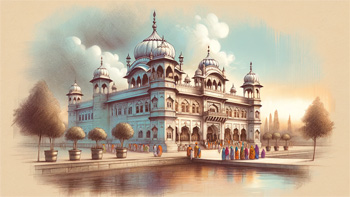A Gurdwara, which literally means the 'Gateway to the Guru,' is a place of worship in Sikhism. More than just a religious building, a Gurdwara serves as a community hub where Sikhs come together for worship, learning, and social service. The concept of the Gurdwara reflects Sikhism's core values such as inclusivity, community service, and the remembrance of God. This article explores the significance, architecture, activities, and the role of Gurdwaras in the Sikh community and beyond.
Significance of the Gurdwara
Gurdwaras play a crucial role in Sikh spirituality and community life. They are open to everyone, regardless of religious background, symbolizing Sikhism's principles of openness and equality. The Gurdwara is not only a space for prayer and meditation but also for communal gatherings and performing 'Seva' (selfless service). It embodies the Sikh ethos of worship, community service, and inclusivity.
Architecture and Structure
The architecture of a Gurdwara is symbolic, reflecting Sikh values and traditions. Typically, a Gurdwara has a Darbar Sahib where the Guru Granth Sahib, the holy scripture of Sikhism, is placed. This hall is a focal point for worship and prayer. Many Gurdwaras also have a Langar hall, where the community kitchen operates, and some may include classrooms, libraries, and accommodation facilities. The Nishan Sahib, a Sikh flag, is often seen flying atop Gurdwaras, symbolizing the presence of a holy space.
Activities in a Gurdwara
Worship in a Gurdwara involves the recitation and singing of hymns from the Guru Granth Sahib. This practice, known as Kirtan, is central to Sikh worship. Apart from religious services, Gurdwaras host Langar, a community meal open to all visitors. Langar serves as a practical demonstration of equality and shared humanity. Other activities include educational programs, discussion groups, and community service initiatives.
Langar: The Community Kitchen
Langar is an integral part of the Gurdwara. Initiated by Guru Nanak, the founder of Sikhism, Langar is a free kitchen where meals are served to all visitors, without distinction of religion, caste, gender, economic status, or ethnicity. This practice fosters a sense of community, equality, and shared responsibility. Volunteers prepare and serve the meals, embodying the Sikh principle of Seva.
The Role of Gurdwaras in the Community
Gurdwaras are not just places of worship but also centers for community development and support. They often provide educational resources, host cultural events, and offer aid during emergencies. Gurdwaras also play a key role in preserving Sikh heritage, language, and traditions, serving as focal points for cultural identity and social cohesion.
Gurdwaras Around the World
While Gurdwaras originated in the Indian subcontinent, they can now be found worldwide, reflecting the global Sikh diaspora. Overseas Gurdwaras often become a nucleus for local Sikh communities, providing a sense of belonging and connection to cultural roots. They are also platforms for interfaith dialogue and cultural exchange, promoting understanding and harmony in diverse societies.
Gurdwaras are much more than places of worship; they are vital institutions that uphold the values of Sikhism. Through their activities, they provide spiritual nourishment, social support, and community engagement. They stand as beacons of Sikh teachings, promoting unity, service, and devotion, and continue to play a significant role in the lives of Sikhs and the wider community worldwide.
